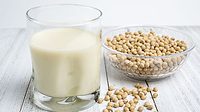Health, sustainability trends put plant proteins in the limelight
Consumer trends continue to drive beverage innovation

Image courtesy of Getty Images
Widely regarded as one of the most influential writers in the German language, polymath and writer Johann Wolfgang von Goethe is quoted for once having said, “Behavior is the mirror in which everyone shows their image.”
Today, as consumer behavior reflects a shift in preference toward natural and organic food and beverages, experts note that the demand for plant proteins also is on the rise.
“It used to be that primarily vegan and vegetarian consumers were interested in plant-based products, but the plant-based market has exploded in the past few years,” says Linnea Halter, marketing coordinator at Global Organics, Cambridge, MA. “The increasing popularity of plant-based diets, driven by factors such as health, ethical concerns and sustainability, has fueled the demand for plant-based protein sources.
“Overall, the plant proteins market has shifted from a niche segment to a mainstream industry,” Halter continues.
Mark Fahlin, business development at Cargill, Minneapolis, echoes similar sentiments, noting that the plant-based beverage space has been one of the most dynamic categories during the past decade.
“Consumers are attracted to these products for a variety of reasons, spanning health perceptions, animal welfare concerns, environmental considerations and the simple desire to try new products,” Fahlin says.
Ravi Arora, sales and marketing director at Global Organics, notes that there’s a growing segment of consumers who resonate with high-protein claims on beverages, and like a protein mix that balances out an amino acid profile.
“Plant proteins offer the necessary variety in this regard, while also creating opportunities for differentiation and innovation in the category,” he says. “There has also been a tremendous level of innovation on sensory aspects in plant-based protein beverages in the last few years.”

Criteria for formulating
As broader sustainability and health trends are driving beverage innovation, experts highlight some considerations to take account when formulating with plant proteins.
“When using plant proteins, product developers have to consider their impact on overall sensory aspects of the finished product,” Global Organics’ Arora says. “Many plant proteins have a dark color or strong beany, grassy, nutty or earthy notes that can affect the color and flavor of the finished product.”
Global Organics’ Halter suggests that beverage-makers also should consider the choice of protein, protein concentration, solubility, texture, pH and stability of the plant protein.
“For example, pea protein is neutral while soy protein has a distinct taste,” Halter explains. “Some plant proteins may clump or sediment, but pre-treating or using isolates can enhance solubility.
“Texture can be gritty or chalky with certain plant proteins,” she continues. “pH and stability must be considered, as some proteins are sensitive to changes.”
Noting that plant proteins are notoriously unstable in more acidic applications, Cargill’s Fahlin points out that the company’s joint venture partner PURIS has expanded its pea protein lineup to address such issues.
“PURIS HiLo pushes past those boundaries offering formulators an acid-stable protein for use in fruit juices, energy shots and other acidic beverages,” he says. “It also brings low viscosity and high solubility, so it won’t impact the final texture of the product.”
Niki Kennedy, director of insights and content at Glanbia Nutritionals, Chicago, notes that formulating with plant proteins requires allowing for various solubility challenges, especially in ready-to-drink (RTD) and ready-to mix (RTM) beverages.
“Dissolvability can be overcome in RTMs by blending, stirring or shaking in the shaker bottle or container. When compared to dairy beverages there are not only flavor concerns, but overall texture and grittiness can create disappointment,” Kennedy says. “And many plant proteins are not complete proteins, which can require blending proteins and longer labels in addition to gums or powdered fats to improve mouth feel.”
Melissa Machen, principal technical account manager for protein ingredients at Cargill, points to processing requirements as another consideration when working with plant proteins.
“At higher inclusion levels (20-plus grams of protein per serving), some plant proteins may clog ultra-high temperature (UHT) machines,” Machen says. “Maintaining mouthfeel over shelf life is another concern as some plant proteins may cause high-protein beverages to become more viscous over time, yielding a final product that’s more akin to pudding than a drink.”
Additionally, where solubility can pose challenges for formulators, Machen notes that there even can be noticeable differences between proteins from the same botanical source — especially as ingredient suppliers develop SKUs that offer improved functionality aligned to specific applications.
“For example, PURIS 2.0, which was developed specifically for beverages, offers enhanced solubility compared to most other pea protein options,” she explains. “As a result, PURIS 2.0 can be used at higher concentrations without diminishing product quality, paving the way for protein-fortified beverages with significantly higher protein levels.”
Further, nutritional considerations also come into play in applications — whether it’s a dry powered mix or a RTD beverage, Machen says.
“On the plant protein front, pea protein has developed a loyal following as the go-to protein-fortifying ingredient,” she says. “It’s high in protein — Cargill’s option from PURIS is at least 80% protein — and it has a solid PDCAAS (protein digestibility corrected amino acid score) of 0.78, well above most plant proteins.”
Philip Caputo, marketing and consumer insights manager at Virginia Dare, Carteret, NJ, alludes to how taste remains central when formulating with plant proteins.
“Plant proteins like soy and faba can carry unpleasant flavors,” he says. “For consumers trying out plant-based protein beverages for the first time, the lack of familiarity with the off-notes is a huge barrier to repeat purchases.”
Caputo highlights that Virginia Dare handles flavor challenges through a threefold approach.
“First, we find a flavor that serves as a good base to complement a plant-based protein. For lingering off-notes, we apply flavor modulation techniques to tone down those unpleasant flavors or bring out the good ones,” he explains. “Then, if the flavor still isn’t right, we go one step further and add a flavor-masking solution. These are natural flavors and taste solutions, so formulators don’t need to worry about ingredients sounding unappealing or contradicting the product’s overall better-for-you message.”
Jennifer Olmstead, senior director of marketing and communications for the California Walnut Board, Folsom, CA, notes that beverage-makers also should consider the affordances of the different plant proteins when it comes to functionality, flavor and texture.
“Beyond these frontline criteria, consumers are purchasing the product to fulfill a need, whether it’s workout recovery or latte art,” she says. “As any barista will share, frothing the most available plant-based dairy alternatives is a challenge because of the lower protein and fat content than in dairy milk.
“There are a couple different ways for beverage-makers to address this,” Olmstead continues. “One solution we think will continue to gain traction is for product developers to consider what other whole ingredients might afford some of the missing functionality. For example, the good fats in walnuts can help the nutrient profile and function of a beverage while still maintaining a clean label.”

Making a difference
Although inflationary pressures recently have impacted the plant-based world, experts note that the future of the plant proteins in the beverage space remains promising.
“Last year, for the first time ever, plant-based milk alternative volumes actually declined,” Cargill’s Fahlin says. “Still, consumers have a quarter of a century of experience with plant-based milk alternatives, and those products have achieved a 10% penetration in the overall fluid milk segment. It’s not a niche, and consumers aren’t just trialing — these products are a part of many people’s lives.”
Virginia Dare’s Caputo also points to how the plant protein market experienced a lull last year.
“As promising as plant-based protein beverages are, brands can’t overlook what’s happening in the broader plant-based protein category, which has been in a slump the past year,” he says. “There’s a rising tide of consumers who see these products as ultra-processed, which calls for increased vigilance from the beverage category.
“Companies can stand apart by delivering meaningful benefits in their plant-based beverages to stay ahead of this shifting mindset,” Caputo continues. “Be transparent about ingredients. Show facts to prove sustainability. Create a bioavailable nutritional profile with a sensory experience on par with animal products. Focus on clean label flavors sourced from real fruit, cocoa, vanilla, coffee, and beyond.”
Cargill’s Fahlin echoes similar sentiments, noting that “there is still plenty of work to be done,” especially as nutrition remains a top priority for many consumers.
“Many of the current offerings have just a gram of protein, while traditional dairy milks have 8 grams per serving and ultra-filtered designer milks can have as much as 40 grams of protein,” he explains. “As brands gain more experience with improved plant-based proteins, that gap will start to close.
“Looking further out, it will be interesting to see how advances such as precision fermentation shape this space and influence product development, opening up new application spaces previously not accessible with traditional proteins,” Fahlin continues. “This technology has the potential to offer a range of benefits, spanning nutritional considerations, sensory expectations and sustainability considerations.”
Global Organics’ Halter says that technological advancements in food science and technology are leading to the development of innovative plant-based proteins and beverages that improve taste, texture and nutritional profiles.
“The market is diversifying rapidly, offering a wider range of plant-based protein sources and beverages beyond traditional options,” she explains. “Functional beverages, such as plant-based protein shakes and sports drinks, cater to different consumer needs. Manufacturers are investing in flavor research to create plant-based beverages that mimic or exceed the taste of animal-based drinks.
“With a focus on sustainability, the future will see an emphasis on sustainable sourcing, production processes, and packaging for plant proteins and beverages,” Halter concludes.
Looking for a reprint of this article?
From high-res PDFs to custom plaques, order your copy today!






